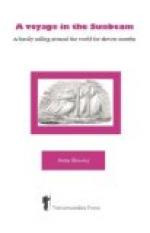III. Four days, January 15 to 18, North Pacific, north-east trades, wind on the quarter, force 5 to 9—1,027 knots. The average speed in this case was 107 knots an hour.
The following were the average speeds of the longer passages:—
Days Total Distance Daily at Distance under Average Sea Steam
1 Cape Verde to Rio 18 3,336 689 185
2 Valparaiso and Yokohama 72 12,333 2,108 171
3 Simonoseki and Aden 37 6,931 4,577 187
The vessel which has carried us so rapidly and safely round the globe claims a brief description. She was designed by Mr. St. Clare Byrne, of Liverpool, and may be technically defined as a composite three-masted topsail-yard screw schooner. The engines, by Messrs. Laird, are of 70 nominal or 350 indicated horse-power, and developed a speed of 10.13 knots on the measured mile. The bunkers contain 80 tons of coal. The average daily consumption is four tons, and the speed eight knots in fine weather. The principal dimensions of the hull are;—Length for tonnage, 157 ft.; beam, extreme, 27 ft. 6 in.; displacement tonnage, 531 tons; area of midship section, 202 square feet.
With an addition of 20 ft. to the length, and more engine power, the ‘Sunbeam’ presents a type which might be found efficient for naval services in distant waters, where good sailing qualities are essential, and large ships are not required.
On looking back, and contrasting the anticipated difficulties with the actual experiences of the voyage, the ease and certainty with which every passage has been made are truly surprising. Our track has been for the most part within the Tropics. The storms off the Cape of Good Hope and Cape Horn have been avoided in the inland passages of the Straits of Magellan and the Suez Canal. We have encountered no continuous stormy weather, except during the four days preceding our arrival at Yokohama. We have suffered discomfort from heat and detention in calms, but storms have disturbed us seldom, and they have not lasted long.
Our experience of gales include a north-east gale off Cape Finisterre, on the outward voyage; a northerly gale between Rio and the River Plate, a westerly gale off the east coast of Patagonia, short but severe gales on each of the four days preceding our arrival at Yokohama, a severe gale from the north-west in the Inland Sea, a north-east gale in the Formosa Channel, a northerly gale in the Straits of Jubal, a westerly gale off Port Said, and an easterly gale on the south coast of Candia. On the passage homewards from Gibraltar we met strong northerly winds on the coast of Portugal, and a north-east gale off Cape Finisterre.
The navigation has presented few difficulties. All the coasts that we have visited have been surveyed. Lighthouses are now as numerous and efficient on the coasts of China and Japan as on the shores of Europe. Such is the perfection of the modern chronometer, that lunar observations, the only difficult work in ocean navigation, are no longer necessary; and the wind charts published by the Admiralty supply to the amateur navigator accumulated information and valuable hints for every stage of his voyage.




